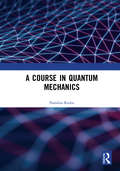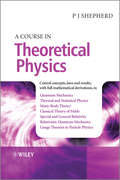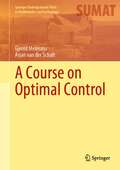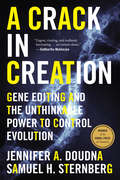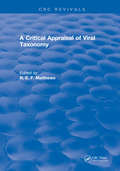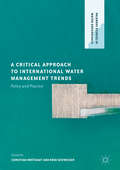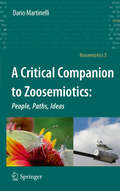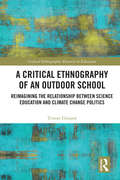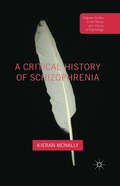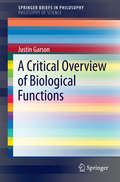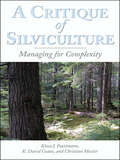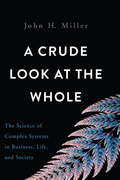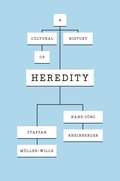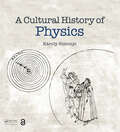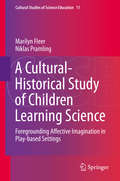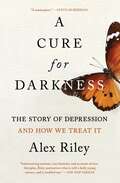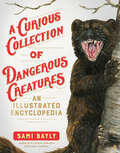- Table View
- List View
A Course in Quantum Mechanics
by Nandita RudraThe book is suitable for graduate and advanced level undergraduate students. Besides standard materials for the course, it also includes modern topics like coherent states, propagators and Feynman's path integral method, Landau levels, Aharonov Bohm Effect, parity operation, time reversal symmetry and Dirac relativisticequation.Please note: Taylor & Francis does not sell or distribute the Hardback in India, Pakistan, Nepal, Bhutan, Bangladesh and Sri Lanka
A Course in Theoretical Physics
by P. John ShepherdThis book is a comprehensive account of five extended modules covering the key branches of twentieth-century theoretical physics, taught by the author over a period of three decades to students on bachelor and master university degree courses in both physics and theoretical physics. The modules cover nonrelativistic quantum mechanics, thermal and statistical physics, many-body theory, classical field theory (including special relativity and electromagnetism), and, finally, relativistic quantum mechanics and gauge theories of quark and lepton interactions, all presented in a single, self-contained volume. In a number of universities, much of the material covered (for example, on Einstein’s general theory of relativity, on the BCS theory of superconductivity, and on the Standard Model, including the theory underlying the prediction of the Higgs boson) is taught in postgraduate courses to beginning PhD students. A distinctive feature of the book is that full, step-by-step mathematical proofs of all essential results are given, enabling a student who has completed a high-school mathematics course and the first year of a university physics degree course to understand and appreciate the derivations of very many of the most important results of twentieth-century theoretical physics.
A Course on Optimal Control (Springer Undergraduate Texts in Mathematics and Technology)
by Arjan van der Schaft Gjerrit MeinsmaThis text provides a detailed and self-contained introduction to the core topics of optimal control for finite-dimensional deterministic dynamical systems. Skillfully designed to guide the student through the development of the subject, the book provides a rich collection of examples, exercises, illustrations, and applications, to support comprehension of the material. Solutions to odd-numbered exercises are included, while a complete set of solutions is available to instructors who adopt the text for their class. The book is adaptable to coursework for final year undergraduates in (applied) mathematics or beginning graduate students in engineering. Required mathematical background includes calculus, linear algebra, a basic knowledge of differential equations, as well as a rudimentary acquaintance with control systems. The book has developed out of lecture notes that were tested, adapted, and expanded over many years of teaching. Chapters 1-4 constitute thematerial for a basic course on optimal control, covering successively the calculus of variations, minimum principle, dynamic programming, and linear quadratic control. The additional Chapter 5 provides brief views to a number of selected topics related to optimal control, which are meant to peak the reader’s interest. Some mathematical background is summarized in Appendix A for easy review. Appendix B recalls some of the basics of differential equations and also provides a detailed treatment of Lyapunov stability theory including LaSalle’s invariance principle, as occasionally used in Chapters 3 and 4.
A Crack in Creation: Gene Editing and the Unthinkable Power to Control Evolution
by Jennifer A. Doudna Samuel H. SternbergA trailblazing biologist grapples with her role in the biggest scientific discovery of our era: a cheap, easy way of rewriting genetic code, with nearly limitless promise and peril. Not since the atomic bomb has a technology so alarmed its inventors that they warned the world about its use. Not, that is, until the spring of 2015, when biologist Jennifer Doudna called for a worldwide moratorium on the use of the new gene-editing tool CRISPR—a revolutionary new technology that she helped create—to make heritable changes in human embryos. The cheapest, simplest, most effective way of manipulating DNA ever known, CRISPR may well give us the cure to HIV, genetic diseases, and some cancers, and will help address the world’s hunger crisis. Yet even the tiniest changes to DNA could have myriad, unforeseeable consequences—to say nothing of the ethical and societal repercussions of intentionally mutating embryos to create “better” humans. Writing with fellow researcher Samuel Sternberg, Doudna shares the thrilling story of her discovery, and passionately argues that enormous responsibility comes with the ability to rewrite the code of life. With CRISPR, she shows, we have effectively taken control of evolution. What will we do with this unfathomable power?
A Criminology of the Human Species: Setting an Unsettling Tone (Palgrave Studies in Green Criminology)
by Yarin EskiThe book sketches out how the criminological lens could be used in the climate change debate around possible human extinction. It explores the extent to which the human species can be considered deviant in relation to other species of the contemporary biosphere, as humans seem to be the only species on Earth that does not live in natural balance with their environment (anymore). It discusses several unsettling topics in the public debate on climate change, specifically the taboo of how humans may not survive the ongoing climate change. It includes chapters on the Earth’s history of mass-extinctions, the global state of denial including toward the possibility that the human species could go extinct, and it considers humans' future as a deviant, fatal species outside of Earth, in outer-space, possibly on other planets. It puts forward and enriches the critical criminological tradition by conceptualizing and setting an unsettling tone within criminology and criminological research on the human species and our extinction, by daring criminologists (and victimologists) to ponder and seek empirical answers to controversial imaginations and questions about our possible extinction.
A Critical Appraisal of Viral Taxonomy
by R. E. MatthewsThe overall aim of this volume is to review critically the current state of, and future prospects for developments in viral taxonomy.
A Critical Approach to International Water Management Trends
by Christian Bréthaut Rémi SchweizerThis edited volume provides a critical discussion of particular trends that are widely recognised to influence water management by comparing them with what is actually happening in the field. Among others, these trends include water security, adaptive or integrative management, and the water-energy-food nexus, which are often presented as essential means to reaching more sustainable and resilient water use. However, the extent to which these trends have managed to structure concrete practices in water management remains uncertain. Informed by empirically grounded research, each chapter of this work engages with a particular approach, concept or theory. Together, they provide a nuanced picture of trends in water management that require universal remedies and global norms.
A Critical Companion to Zoosemiotics: People, Paths, Ideas (Biosemiotics #5)
by Dario MartinelliA critical companion of zoosemiotics is the first attempt to systematise the study of animal communication and signification through its most important and/or problematic terms and concepts, and its most representative scholars. It is a companion, in that it attempts to cover the entire range of key terms in the field, and it's critical, in that it aims not only to describe, but also to discuss, problematise and, in some cases, resolve, these terms.
A Critical Ethnography of an Outdoor School: Reimagining the Relationship between Science Education and Climate Change Politics (Critical Ethnographic Research in Education)
by Tristan GleasonBy using critical ethnographic research to explore the practices and policies that sustain a residential outdoor school in the US, this volume problematizes the relationship between science education and climate change politics in the United States. Weaving together empirical data from field work with theoretical resources spanning the sciences and humanities, this volume demonstrates how community activism, political alliances, and policy change have guaranteed the survival of an outdoor school in Oregon. This example enables artful re-examination of the relationship between science education, politics, and policy more broadly, as well as the relation of science education to climate change politics in particular. Gleason ultimately reconstructs science education towards epistemic and ontological pluralism, and illustrates how critical ethnographic research can instigate a reimagining of the relationship between curriculum and how we relate to the world. This text will benefit researchers, academics, and educators in higher education with an interest in the philosophical underpinnings and implications of science education, environmental education, and educational policy more broadly. Those specifically interested in critical ethnographic research will also benefit from this book.
A Critical Examination of the Position of Mr. Darwin's Work, "On the Origin of Species"
by Thomas Henry HuxleyN/A
A Critical History of Schizophrenia (Palgrave Studies in the Theory and History of Psychology)
by Kieran McNallySchizophrenia was 20th century psychiatry's arch concept of madness. Yet for most of that century it was both problematic and contentious. This history explores schizophrenia's historic instability via themes such as symptoms, definition, classification and anti-psychiatry. In doing so, it opens up new ways of understanding 20th century madness.
A Critical Overview of Biological Functions (SpringerBriefs in Philosophy)
by Justin GarsonThis book is a critical survey of and guidebook to the literature on biological functions. It ties in with current debates and developments, and at the same time, it looks back on the state of discourse in naturalized teleology prior to the 1970s. It also presents three significant new proposals. First, it describes the generalized selected effects theory, which is one version of the selected effects theory, maintaining that the function of a trait consists in the activity that led to its differential persistence or reproduction in a population, and not merely its differential reproduction. Secondly, it advances "within-discipline pluralism" (as opposed to between-discipline pluralism) a new form of function pluralism, which emphasizes the coexistence of function concepts within diverse biological sub-disciplines. Lastly, it provides a critical assessment of recent alternatives to the selected effects theory of function, namely, the weak etiological theory and the systems-theoretic theory. The book argues that, to the extent that functions purport to offer causal explanations for the existence of a trait, there are no viable alternatives to the selected effects view. The debate about biological functions is still as relevant and important to biology and philosophy as it ever was. Recent controversies surrounding the ENCODE Project Consortium in genetics, the nature of psychiatric classification, and the value of ecological restoration, all point to the continuing relevance to biology of philosophical discussion about the nature of functions. In philosophy, ongoing debates about the nature of biological information, intentionality, health and disease, mechanism, and even biological trait classification, are closely related to debates about biological functions.
A Critique of Silviculture: Managing for Complexity
by K. David Coates Klaus J. Puettmann Christian C. MessierThe discipline of silviculture is at a crossroads. Silviculturists are under increasing pressure to develop practices that sustain the full function and dynamics of forested ecosystems and maintain ecosystem diversity and resilience while still providing needed wood products. A Critique of Silviculture offers a penetrating look at the current state of the field and provides suggestions for its future development. The book includes an overview of the historical developments of silvicultural techniques and describes how these developments are best understood in their contemporary philosophical, social, and ecological contexts. It also explains how the traditional strengths of silviculture are becoming limitations as society demands a varied set of benefits from forests and as we learn more about the importance of diversity on ecosystem functions and processes. The authors go on to explain how other fields, specifically ecology and complexity science, have developed in attempts to understand the diversity of nature and the variability and heterogeneity of ecosystems. The authors suggest that ideas and approaches from these fields could offer a road map to a new philosophical and practical approach that endorses managing forests as complex adaptive systems. A Critique of Silviculture bridges a gap between silviculture and ecology that has long hindered the adoption of new ideas. It breaks the mold of disciplinary thinking by directly linking new ideas and findings in ecology and complexity science to the field of silviculture. This is a critically important book that is essential reading for anyone involved with forest ecology, forestry, silviculture, or the management of forested ecosystems.
A Crude Look at the Whole: The Science of Complex Systems in Business, Life, and Society
by John H. MillerImagine trying to understand a stained glass window by breaking it into pieces and examining it one shard at a time. While you could probably learn a lot about each piece, you would have no idea about what the entire picture looks like. This is reductionism--the idea that to understand the world we only need to study its pieces--and it is how most social scientists approach their work. In A Crude Look at the Whole, social scientist and economist John H. Miller shows why we need to start looking at whole pictures. For one thing, whether we are talking about stock markets, computer networks, or biological organisms, individual parts only make sense when we remember that they are part of larger wholes. And perhaps more importantly, those wholes can take on behaviors that are strikingly different from that of their pieces. Miller, a leading expert in the computational study of complex adaptive systems, reveals astounding global patterns linking the organization of otherwise radically different structures: It might seem crude, but a beehive’s temperature control system can help predict market fluctuations and a mammal’s heartbeat can help us understand the "heartbeat” of a city and adapt urban planning accordingly. From enduring racial segregation to sudden stock market disasters, once we start drawing links between complex systems, we can start solving what otherwise might be totally intractable problems. Thanks to this revolutionary perspective, we can finally transcend the limits of reductionism and discover crucial new ideas. Scientifically founded and beautifully written, A Crude Look at the Whole is a powerful exploration of the challenges that we face as a society. As it reveals, taking the crude look might be the only way to truly see.
A Cultural History of Heredity
by Staffan Muller-Wille Hans-Jorg RheinbergerIt was only around 1800 that heredity began to enter debates among physicians, breeders, and naturalists. Soon thereafter it evolved into one of the most fundamental concepts of biology. Here Staffan Müller-Wille and Hans-Jörg Rheinberger offer a succinct cultural history of the scientific concept of heredity. They outline the dramatic changes the idea has undergone since the early modern period and describe the political and technological developments that brought about these changes. Müller-Wille and Rheinberger begin with an account of premodern theories of generation, showing that these were concerned with the procreation of individuals rather than with hereditary transmission. The authors reveal that when hereditarian thinking first emerged, it did so in a variety of cultural domains, such as politics and law, medicine, natural history, breeding, and anthropology. Müller-Wille and Rheinberger then track theories of heredity from the late nineteenth century—when leading biologists considered it in light of growing societal concerns with race and eugenics—through the rise of classical and molecular genetics in the twentieth century, to today, as researchers apply sophisticated information technologies to understand heredity. What readers come to see from this exquisite history is why it took such a long time for heredity to become a prominent concept in the life sciences and why it gained such overwhelming importance in those sciences and the broader culture over the last two centuries.
A Cultural History of Heredity
by Hans-Jörg Rheinberger Staffan Müller-Wille&“Thought-provoking…any scientist interested in genetics will find this an enlightening look at the history of this field.&”—Quarterly Review of Biology It was only around 1800 that heredity began to enter debates among physicians, breeders, and naturalists. Soon thereafter, it evolved into one of the most fundamental concepts of biology. Here, Staffan Muller-Wille and Hans-Jorg Rheinberger offer a succinct cultural history of the scientific concept of heredity. They outline the dramatic changes the idea has undergone since the early modern period and describe the political and technological developments that brought about these changes. They begin with an account of premodern theories of generation, showing that these were concerned with the procreation of individuals rather than with hereditary transmission, and reveal that when hereditarian thinking first emerged, it did so in a variety of cultural domains, such as politics and law, medicine, natural history, breeding, and anthropology. The authors then track theories of heredity from the late nineteenth century—when leading biologists considered it in light of growing societal concerns with race and eugenics—through the rise of classical and molecular genetics in the twentieth century, to today, as researchers apply sophisticated information technologies to understand heredity. What we come to see from this exquisite history is why it took such a long time for heredity to become a prominent concept in the life sciences, and why it gained such overwhelming importance in those sciences and the broader culture over the last two centuries.
A Cultural History of Physics
by Károly SimonyiWhile the physical sciences are a continuously evolving source of technology and of understanding about our world, they have become so specialized and rely on so much prerequisite knowledge that for many people today the divide between the sciences and the humanities seems even greater than it was when C. P. Snow delivered his famous 1959 lecture, "The Two Cultures." In A Cultural History of Physics, Hungarian scientist and educator Károly Simonyi succeeds in bridging this chasm by describing the experimental methods and theoretical interpretations that created scientific knowledge, from ancient times to the present day, within the cultural environment in which it was formed. Unlike any other work of its kind, Simonyi’s seminal opus explores the interplay of science and the humanities to convey the wonder and excitement of scientific development throughout the ages. These pages contain an abundance of excerpts from original resources, a wide array of clear and straightforward explanations, and an astonishing wealth of insight, revealing the historical progress of science and inviting readers into a dialogue with the great scientific minds that shaped our current understanding of physics. Beautifully illustrated, accurate in its scientific content and broad in its historical and cultural perspective, this book will be a valuable reference for scholars and an inspiration to aspiring scientists and humanists who believe that science is an integral part of our culture.
A Cultural History of Waste Disposal: Environmental Policy and Park Redevelopments (Routledge Environmental History)
by Benjamin A. LawsonThis book offers a historical analysis of landfill sites in New York City, Greater Toronto, and Greater Tel Aviv, and uses them as case studies to emphasize the international and global scale of issues concerning waste disposal and park redevelopments.New York, Toronto, and Tel Aviv are currently redeveloping giant landfills into parks to much fanfare. The park redevelopments may be seen as an attempt to erase or assuage the decades of problematic waste-disposal policy that led to the creation of such large landfills. Booster rhetoric underscores this point, such as promoting how the parks will be a “green lung” for the city. This book contextualizes these redevelopments by offering a historical analysis, providing a greater understanding of the past, current, and future potential issues. It goes on to analyze the language and media coverage surrounding former waste sites becoming park redevelopments, including how cities use art to promote their image and gain cultural relevance. By engaging with both the works of waste historians and literature on waste and discard studies, the book provides theoretical models for analyzing the role of power in municipal systems, as well as human and ecological impacts on waste. It concludes with an analysis of the features necessary for landfill parks to be successful. This book will be useful for scholars, researchers, and academics studying waste studies, the environment, cities, and sustainable development, as well as for policymakers and environmental/eco artists.
A Cultural-Historical Study of Children Learning Science: Foregrounding Affective Imagination in Play-based Settings (Cultural Studies of Science Education #11)
by Marilyn Fleer Niklas PramlingThis book moves beyond the traditional constructivist and social-constructivist view of learning and development in science. It draws upon cultural-historical theory in order to theorise early childhood science education in relation to our currently globalised education contexts. The book argues that concept development in science for young children can be better theorised by using Vygotsky's concept of Imagination and creativity, Vygotsky's theory of play, and his work on higher mental functions, particularly the concept of inter and intrapsychological functioning. Key concepts are extracted from the theoretical section of the book and used as categories for analysis in presenting evidence and new ideas in the second section of the book. In this second part of the book, the authors examine how science knowledge has been constructed within particular countries around the globe, where empirical research in early childhood science education has occurred. The third part of the book examines the nature of the encounter between the teacher and the child during science learning and teaching. In the final part of the book the authors look closely at the range of models and approaches to the teaching of early childhood science that have been made available to early childhood teachers to guide their planning and teaching. They conclude the book with a theoretical discussion of the cultural-historical foundation for early childhood science education, followed by a model of teaching scientific concepts to young children in play-based settings, including homes and community contexts.
A Cure for Darkness: The Story of Depression and How We Treat It
by Alex RileyA fascinating look at the treatment of depression, blending journalism, science, history, and memoir, by an award-winning science writer.What is depression? Is it a persistent low mood or a complex range of symptoms? Is it a single diagnosis or a diversity of mental disorders requiring different treatments? In A Cure for Darkness, science writer Alex Riley explores these questions, digging into the long history of depression and chronicling the lives of psychiatrists and scientists who sought cures for their patients. Since 2015, Riley has received both cognitive behavioral therapy and antidepressants for his own depression. Throughout his treatment, he wondered—are antidepressants effective? Do short-term talking therapies actually work? And what treatments are on the horizon for those who don&’t respond to these first-line treatments? Expanding from his own experience, he tracks treatments through history, from the &“talking cure&” to electroconvulsive therapy to magic mushrooms. With depression fast becoming the leading burden of disease around the world, the future of mental healthcare depends not just on the development of new therapies, but on increasing access for people who are currently without. Reporting on the field of global mental health from its colonial past to the present day, Riley highlights a range of scalable therapies, including how a group of grandmothers stands on the frontline of a mental health revolution. Weaving in personal and family history, A Cure for Darkness is a gripping narrative journey and a surprisingly hopeful work that delves deep into the science of mental health.
A Cure for the Hiccups
by Naomi Kinsman DowningHave you ever had the hiccups? Amber and her sister want to find a cure! After multiple attempts, though, they still haven’t figured one out. Learn about why we get the hiccups and whether or not there’s a cure!
A Curious Collection of Dangerous Creatures: An Illustrated Encyclopedia (Curious Collection of Creatures #0)
by Sami BaylyFrom the frightening murder hornet to the fierce wolverine—a visual trove of the most dangerous animals on the planet, from the author of the beloved A Curious Collection of Peculiar Creatures Sharks, snakes, and spiders get all the attention, but many of the most terrifying animals on the planet are probably ones you didn’t know were so dangerous—like the otherworldly blue dragon, a tiny sea slug that can unleash a powerful sting, or the lethal mosaic crab, armed with a toxin 1,000 times deadlier than cyanide. And some creatures get rather creative when it comes to warding off predators—which is what makes them so amazing to read about. Take the adorable greater slow loris: This primate prepares to strike by first licking its venom-filled armpits! Before you run and hide, award-winning author and illustrator Sami Bayly shows how, once you understand why these animals have adapted to be so dangerous, you’ll learn to appreciate their scarier sides. They’re only trying to survive! And with so many of these species threatened or endangered, they’re counting on us to learn to love and protect them . . . from a safe distance! Publisher’s note: A Curious Collection of Dangerous Creatures was previously published in Australia under the title The Illustrated Encyclopaedia of Dangerous Animals.
A Curious Collection of Peculiar Creatures: An Illustrated Encyclopedia (Curious Collection of Creatures #0)
by Sami BaylyMake way for the world’s weirdest, most wonderful creatures—from the author of the forthcoming A Curious Collection of Dangerous Creatures Publisher’s Note: A Curious Collection of Peculiar Creatures was previously published in Australia as The Illustrated Encyclopaedia of Ugly Animals. What’s your favorite animal—a majestic lion, a graceful horse? Those are great choices, but have you considered the fangtooth moray eel? It has two rows of icicle-shaped teeth! And the monkey slug caterpillar is ready to cuddle . . . just look out for the stingers all over its body (and its six limbs that technically aren’t legs)! It’s true, these animals are a little different—but their unusual features often give them incredible superpowers. Take the nearly blind star-nosed mole: Its pink, flower-shaped nose can detect the microscopic texture of everything it touches, and it does this at warp speed—up to 12 objects per second! What’s more, many of these weird, wonderful creatures need our help: They’re endangered, and we can’t afford to ignore their well-being any longer. It’s time to find a peculiar creature to love! Why not the blobfish?
A Curious Collection of Wild Companions: An Illustrated Encyclopedia Of Inseparable Species (Curious Collection of Creatures #0)
by Sami BaylyHeartwarming, surprising, and downright bizarre creature connections Relationships can be complicated, and it’s no different in the wild. Meet 60 dynamic duos across the plant and animal kingdom—from “aww” to “eek”! The Eltham copper butterfly and the Notoncus ant are BFFs for life. The ants lovingly raise the butterflies’ caterpillar babies, while feasting on the sweet substance the caterpillars produce. Everybody wins in this prime example of mutualism. The pseudoscorpian is a total freeloader. When it wants to get around, it boards the back of the giant harlequin beetle, in a one-sided setup called commensalism. Parasitism is where things get spooky. Learn how the green-banded broodsac (a type of flatworm) first invades the eyestalk of the amber snail, then tricks it into getting eaten by a bird—inside which the broodsac will grow up. Yikes! Award-winning author and illustrator Sami Bayly shows us a whole world of wild companions like these—many endangered—and reminds us that we’re all inseparable.
A Curious Mind
by Andrew MatthewsBenjamin Franklin was often curious about the world around him. Utilizing observation and testing of the scientific method, he was able to invent many new items that improved the world for others. These inventions include his famous bifocal glasses, lightning rod, and even a long extension arm.
